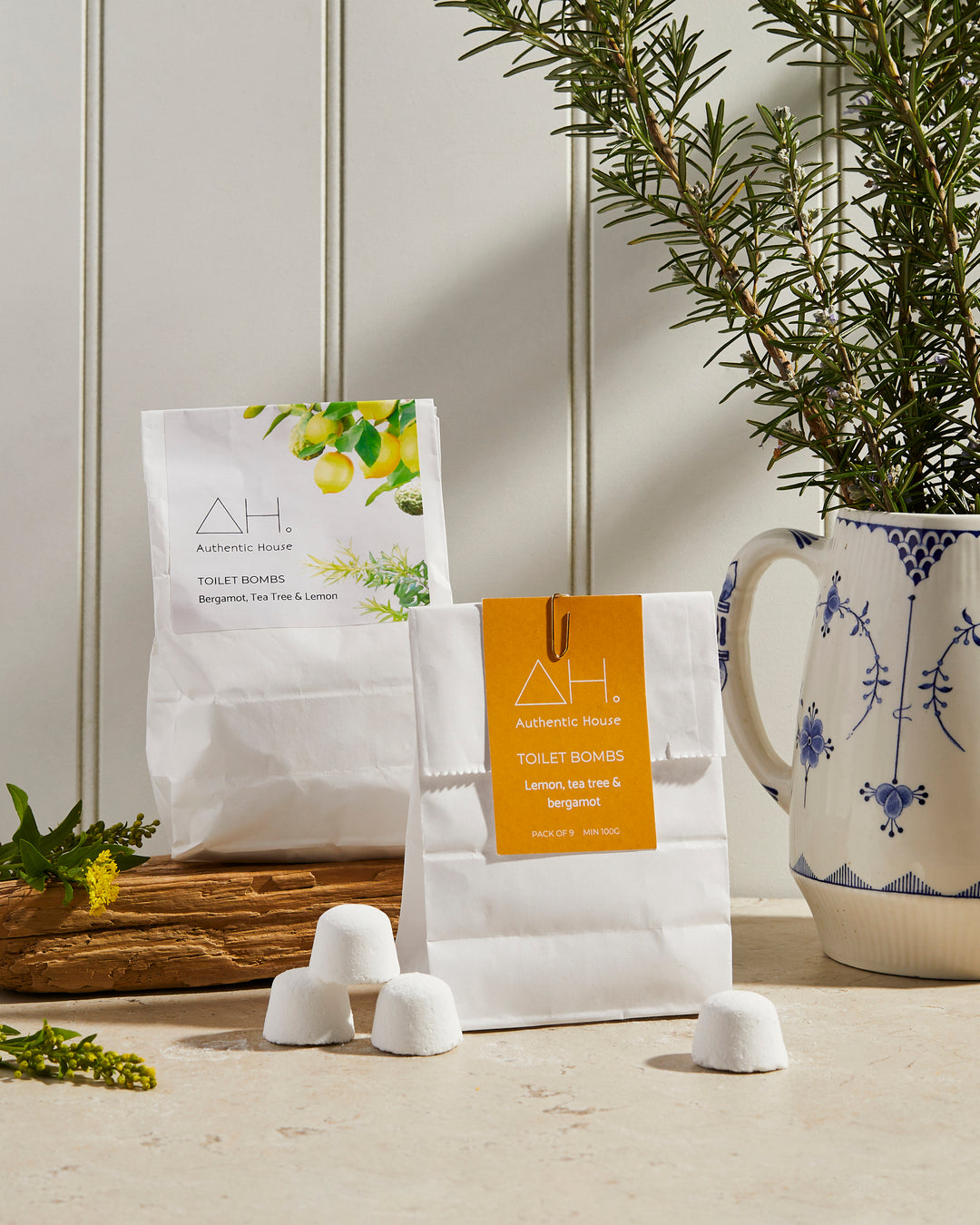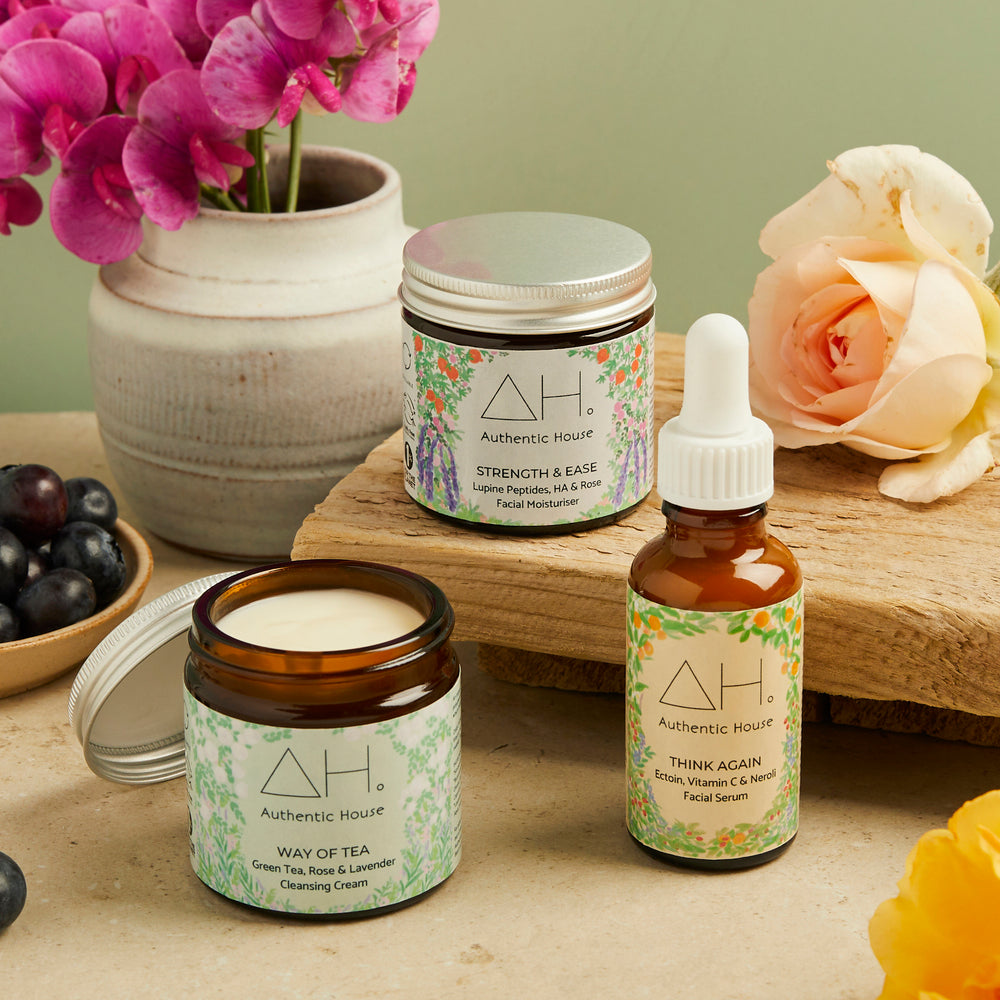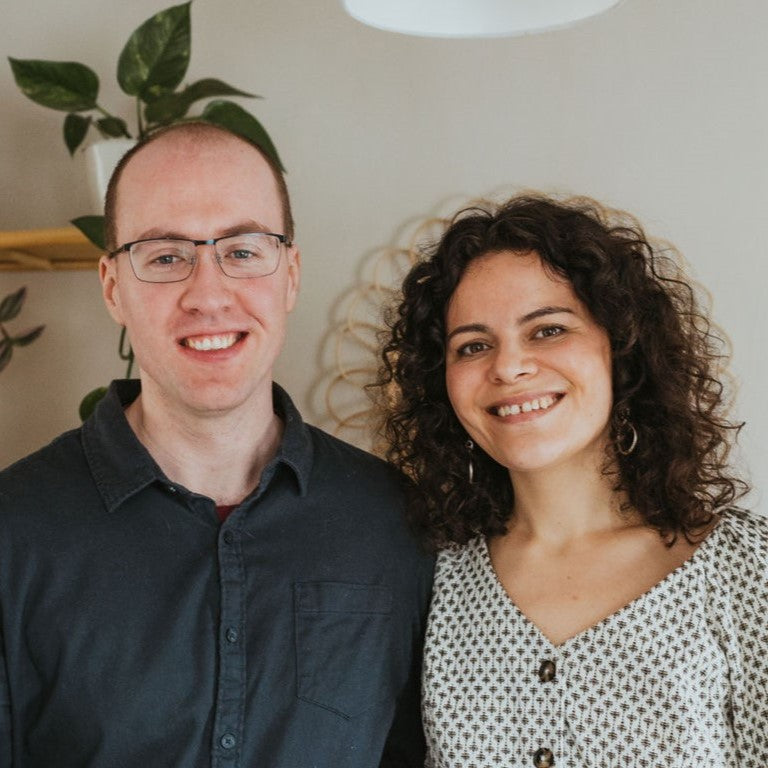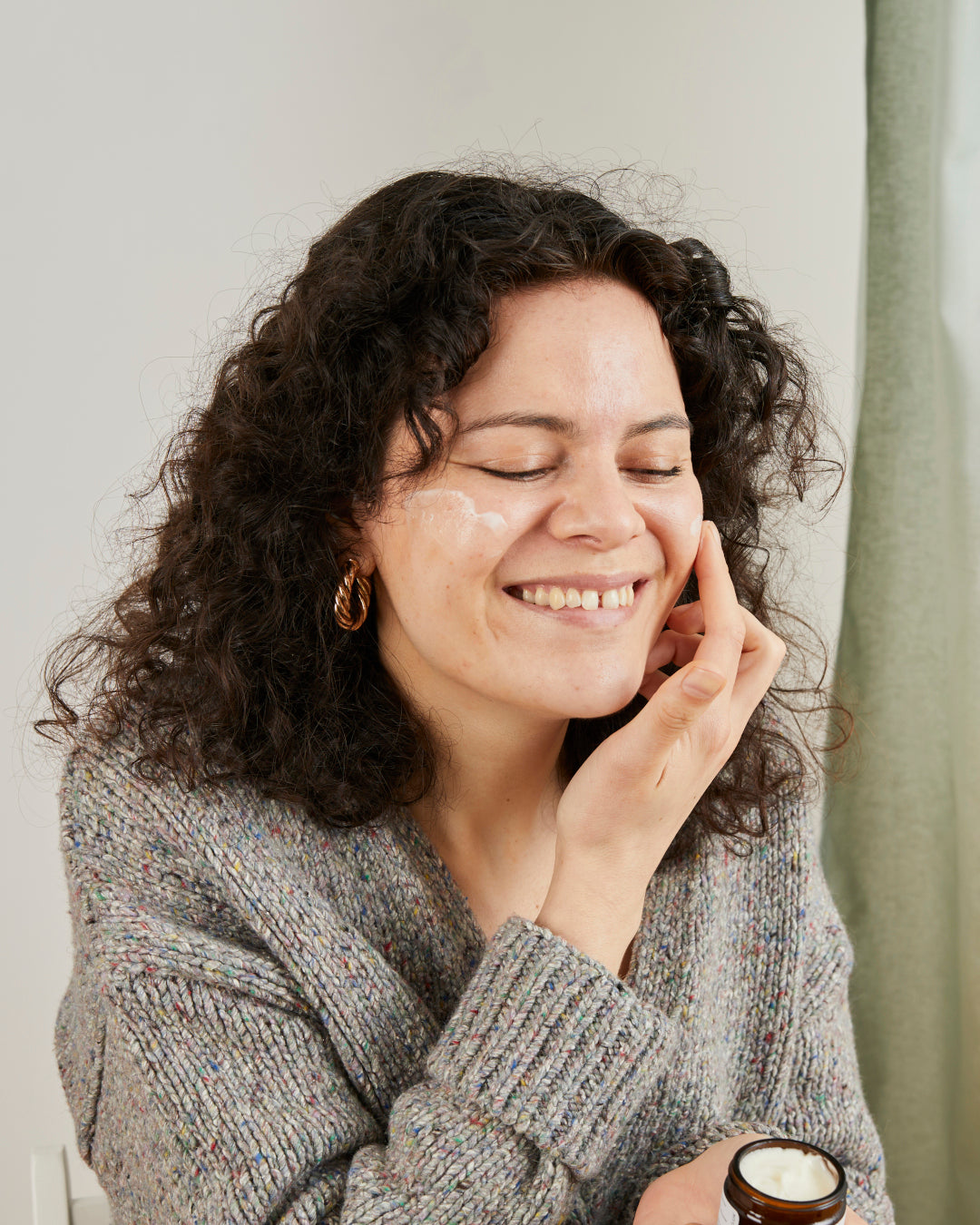The making of our scented candles

This is the story of my journey into the flickering world of scented candles, while staying true to our ethos. From the very beginning, I asked myself, "What's the most sustainable way to do this?"
Candles have held a special place in Authentic House since our beginnings. If you received our first subscription boxes, you might remember our Ahimsa candle with rose petals. While burning something may seem counterintuitive to sustainable living, candles have always been incredibly popular with you. Perhaps it goes back to the primal way a flame grounds us. Let's not forget scent itself is closely linked to memories.
We've offered candles for years now. However, it was when our maker stepped down suddenly that I eventually realised I would have to step up. And, to be honest, I really wanted to.
This is what I learnt. I love the process of candle making. What I hadn't expected was the secrecy around perfumes. I wanted to share with you here how I navigated the choices in materials and processes to make our candles. You'll see I've made them as sustainable as possible. With this story, you might get an idea of the blurred lines of sustainability, where one value comes against another. It's a perfect example really of sustainable living, or here sustainable design. It means navigating matching your values to what you can practically do. I hope it's helpful to you reading this, and a reminder we're all imperfect and doing our best!
The Inspiration Behind Our Scented Candles
The scents we choose for our candles have always come from you, and what you're asking for at the time.
Take Jasmine & Honeysuckle and Patchouli, Black Pepper & Vanilla, our first two scents. These were actually the result of Instagram polls! I asked you for the scent combinations you would love to see and these were the ones you chose.
I can tell you about Jasmine & Honeysuckle. The idea came from my mentor Suzie when she was staying in a villa in Greece in 2020. She became my mentor after a programme with Red Bull supporting social enterprises. It just happened to be during the year of the pandemic. I remember my Zoom calls to her from her home in warm Greece. She would tell me about the flowers that bloomed everywhere. For me, jasmine reminds me of a stay as a student in Benalmadena in Spain. After long nights out, the heady scent of it would welcome us home to bed. Honeysuckle of course we all know and I often will stop to taste one when I walk by. Its scent is sweet and nectary, balanced with fresh green tea and citrus in our candle.
Rose & Sandalwood
Rose & Sandalwood, our newest candle, is one that puts together your favourites too. Looking back to our first candles, the classic scent of rose was always a favourite. Did you know a single rose has many notes within it? It's a scent that makes me pause and brings me back to a moment on sunny days leaning in to smell a flower. Over time, I've found sandalwood is your favourite wood too. It's a wood I haven't yet used in my skincare because of sustainability issues linked to overharvesting If you're ever looking for sandalwood essential oil, make sure it's from Australia. Using sandalwood in our candles doesn't come with this sustainability issue as we're choosing fragrance oils. More on that below.
If you look at our scents, you'll see they're all inspired by nature. Yes I love gourmand and ozonic scents, but mainly here you'll find notes anchored to plants, flowers and spices.

Ingredients and Sustainability
Choosing the Wax
When it comes to candle making, the most important ingredient to select is the wax. It's because it makes up the greatest weight of the candle as a whole. I spent days researching this summer, looking first for an organic candle wax. The only one I could find wasn't vegan as it contained beeswax, an ethical issue for us.
Coconut Wax
I settled back on coconut wax which we'd originally had in our candles. We chose coconut as a sustainable crop that growers can harvest without cutting down the coconut trees. We all benefit from carbon capture as the trees grow. Coconut farmers usually grow their trees on existing agricultural land. Extracting wax from coconuts is actually pretty minimal in processing, reducing waste and chemicals.
Coconut & Soy Wax
Coconut wax is too soft in candles for use by itself though, so for this I've tried two blends. As I began by reformulating Jasmine & Honeysuckle and Patchouli, Black Pepper & Vanilla, I wanted to make use of our existing labels so went with a Coconut and Soy wax blend from a sustainable range. This is a blend of a few plant-based waxes that burn beautifully. Our supplier has sourced these with a commitment to protecting sensitive environments, ending deforestation and promoting responsible working conditions.
Coconut & Rapeseed Wax
For our new scented candle, Rose & Sandalwood, I went a step further and tried a coconut and rapeseed wax blend from the same supplier. This has more sustainability information and will be my wax of choice for new candles. The rapeseed is grown in Europe. Smallholder farmers grow the coconuts in the Philippines and Indonesia (a third of Filipino farmers and their families make a living from coconuts). Our supplier doesn't allow forest removal for the planting of new coconut trees and closely monitors the farmers to ensure this. The supplier has created a programme to train farmers in sustainable coconut agricultural practices.
Choosing our Fragrance
This is another difficult question that I spent months going and forward over. It was the question of whether to use essential oils, fragrance oils or organic essential oils.
Essential Oils
Here's where I landed. I listened to a podcast with two environmentalists a while ago that made me realise essential oils aren't as sustainable as we might think. Essential oils are concentrated, aromatic liquids extracted from plant materials. They can be very powerful and often smell beautiful too. The issue is that many have a very low yield. Take neroli essential oil. 450kg of orange blossom yield just 450g of essential oil. This means we use a lot of land to grow them, which we could otherwise use for food production or leave for nature. If the essential oil isn't organic, that will mean the use of pesticides for many crops and a way of growing that doesn't respect nature.
So I looked into organic essential oils. I couldn't find any organic blends and would have had to create my own - as I did for our skincare. This was completely possible, but I would have had to arrange outside reporting and testing for the blend which was less accessible as a small business.
I also realised that using essential oils in candles would limit me to very few fragrances. In terms of accessibility, that may have just been sweet orange, geranium, mandarin... They're all scents I love, but candle burning puts using essential oils further into question. When I make skincare, I never add essential oils at a temperature about 40C as it would damage them. In a candle, they're heated to far more and, while essential oil candles can smell wonderful unlit, they're known not to have a very powerful hot throw (the aroma you can smell when the candle is lit).
Fragrance Oils
Which is to say, I've chosen fragrance oils. Fragrance oils contain aromatic compounds that can be naturally or synthetically made. To give you an idea of this, take the scent of vanilla.
Vanillin is a compound found in fragrance oils that's a key component to the scent and flavour of vanilla. While it can be derived naturally from the vanilla bean (Vanilla planifolia), it is often synthesized from other natural sources such as lignin, a component of wood pulp. Using cheaper materials isn't only more accessible. It means using what's readily available or perhaps a by-product of another process, so minimising our environmental impact.
That said, I had a shock when I realised one candle I was close to releasing contained phthalates. Diethyl phthalate is in over half of the scented candle fragrances I considered. There is however a growing body of research showing that this plasticiser is an endocrine disruptor, meaning it can lead to hormonal imbalances. I had to remove this candle, Winter Berries & Cinnamon for now, as I couldn't find any way to recreate it without phthalates.

Crafting our Scented Candles
This year I've begun to make many of our products by hand in our home in Cardiff. I love pouring candles, and it was easy to begin after the experience of creating our skincare.
For each candle, I heat the wax just to the point where it's melted before adding fragrance oil and waiting for it to cool ready to pour.
If you've every come to the end of a candle only to find a foam pad at the bottom, this is because most wicks are secured with a foam adhesive. I attach mine with a glue gun using an environmentally friendly glue. It takes a little longer, but avoids lots of single-use plastic.
The candles then set before being finished and labelled.
I've tested each scented candle to make sure it burns well, and have also sent them for soot tests to ensure they burn as cleanly as they can too. This has meant many hours spent working alongside burning candles, measuring the flames, looking out for soot and making sure they reach an even melt pool. All our candles burn for at least 24 hours, but I'm proud that particularly Jasmine & Honeysuckle and Patchouli, Black Pepper & Vanilla can burn for even longer! If you're trying our coconut rapeseed candles, for example in Rose & Sandalwood, you'll see these burn a little differently and leave a trace around the edges of the tin. There's no need to worry as this all melts down in the final few burns.

Illustrating our Scented Candles
This is something I've done from the very beginning as I always essentially knew that part of the joy of a candle is having it sit in your home, unlit for a while, just to savour and enjoy with a little cold throw.
I created our first Winter Berries & Cinnamon candle simply tracing a photograph of juniper, cranberry and elder leaves and fruit with a mouse using vectors. It was very simple, but incredibly intricate and took me hours!
Moving on from there, my sister gave me her digital drawing pad and I illustrated Patchouli, Black Pepper & Vanilla and Jasmine & Honeysuckle this way. They were also very detailed because I hadn't quite realised just how small a design ends up being once it's printed on a label. If you have either of these scented candles, look closely at them and you'll see all the details that have only just made it into sight!
My Rose & Sandalwood candle is my newest and part of a new series of fragrances we're releasing into autumn. For this, I'd learnt my lesson on the details and had also had lots of practice watercolour painting roses and leaves for my friend's wedding Order of the Day poster. It meant I took a lighter and faster approach for this and our upcoming illustrations. I was also under time pressure to get these ready for a last-minute photoshoot slot that had opened up! You'd have seen me working late with cups of Pukka Peace tea, using a digital watercolour brush, creating simpler illustrations that focused only on what you'd actually see at the scale. I love their momentum too!

Exploring what it is to make a sustainable candle
This was my first foray into the world of scented candle making, trying to make the most sustainable choices I could within the limits of time and budget that come with being a small business with winter fast approaching. I hope you've enjoyed reading this and have learnt something too to help you decide which candles are right for you and what to ask candle makers in future too when you buy from them.
As you can see, my new scented candles have many elements that are sustainable. They're locally made, using the most sustainable, vegan wax available, and they're minimising land use through fragrance oils.
There are elements that could be improved too. I'm still searching for an organic vegan wax and ideally I would use entirely natural fragrance oils. Our wicks use a small amount of paraffin wax, which I only realised later on, and ideally I'll find plant-based wicks. The reality is the candle industry is still geared much more towards great scents than sustainability, but I will improve as I go and find more options - or perhaps gain the volume to ask for them.
Conclusion
To wrap things up, I want to be completely open with you. Our Jasmine & Honeysuckle, Patchouli, Black Pepper & Vanilla, and Rose & Sandalwood Candles have just arrived for the autumn season, and I'm so happy to finally share them with you. If, as with candles, I can set an intention, it's for these flames to bring presence, joy and perhaps a memory-evoking scent to your home.
I'd love to know what you think of my scented candles, and of the process to creating them too. As always, our aim is to inspire you on your own path to sustainable living with the beautiful, low waste and uniquely everyday products that can support you in this process.





















Thank you! I’m so glad you found my post helpful. It really is a grey area choosing fragrance for sustainability and I think it starts with working out what matters to you first – and being open to change as we all learn too.
Purely awesome to read your post and look at the deep insights of your candle making process. I am glad to know that any favorite essential oils and fragrance oils could be infused in the candles nowadays.
The detailed explanation of the fragrance selection process is enlightening. It’s great to see the thoughtfulness in opting for fragrance oils over essential oils, considering both environmental impact and accessibility.
What an insightful and educational read! Very much enjoyed learning more about your creation and the things you found along the way during sourcing and production. It has helped open my eyes to sourcing sustainable materials and makes my heart full knowing the care that has gone into the curation of these wonderful candles. Will be reflecting on this when next enjoying my beautiful candles. Thank you for sharing this article with us!
Leave a comment